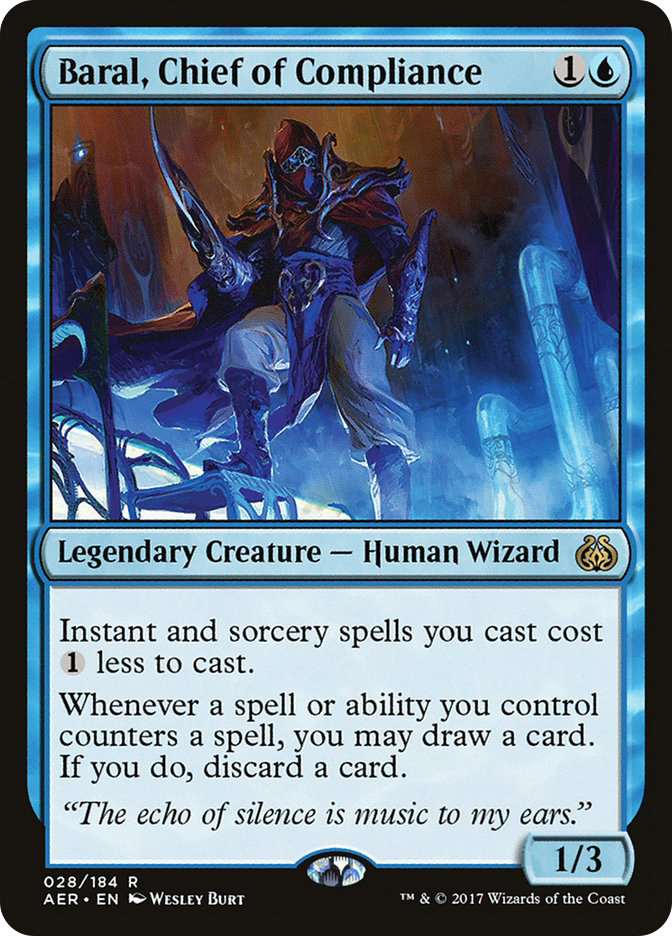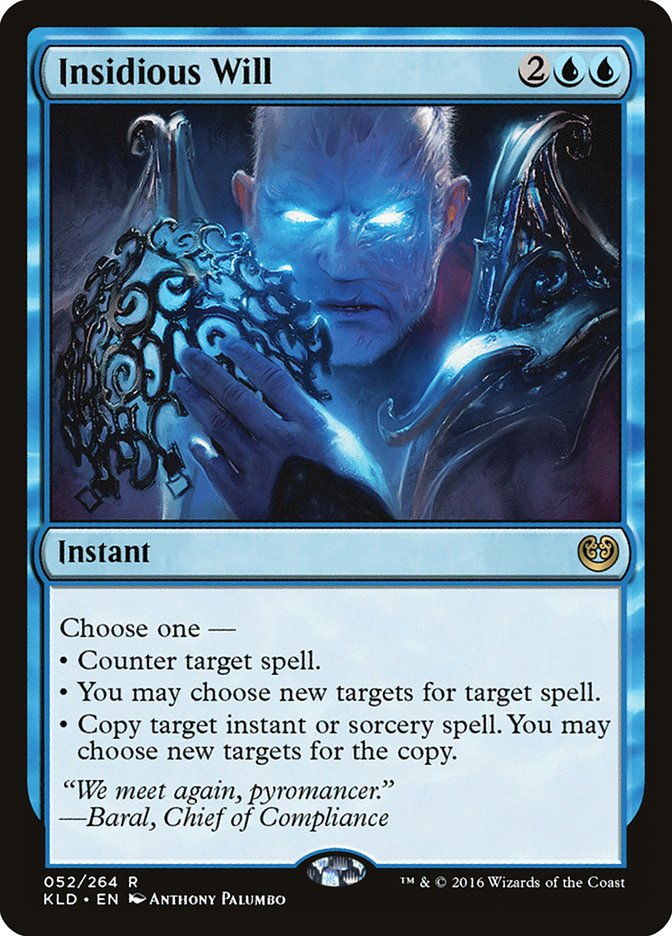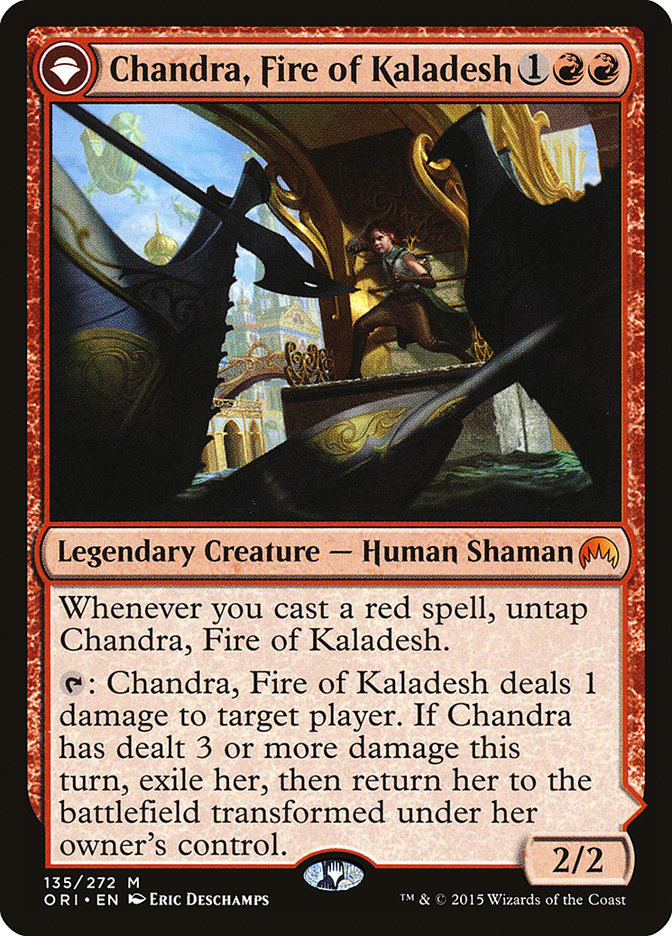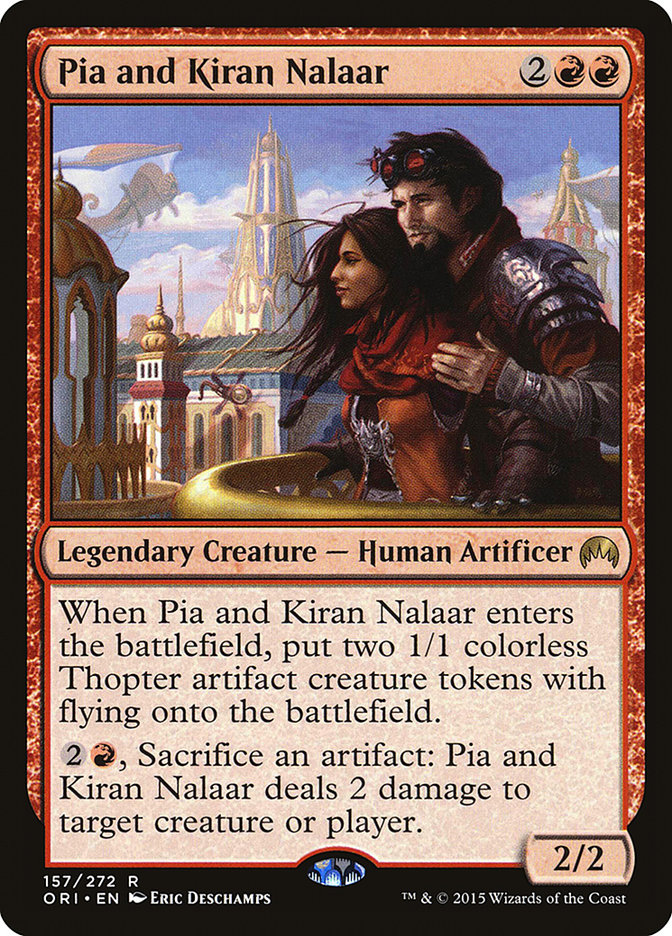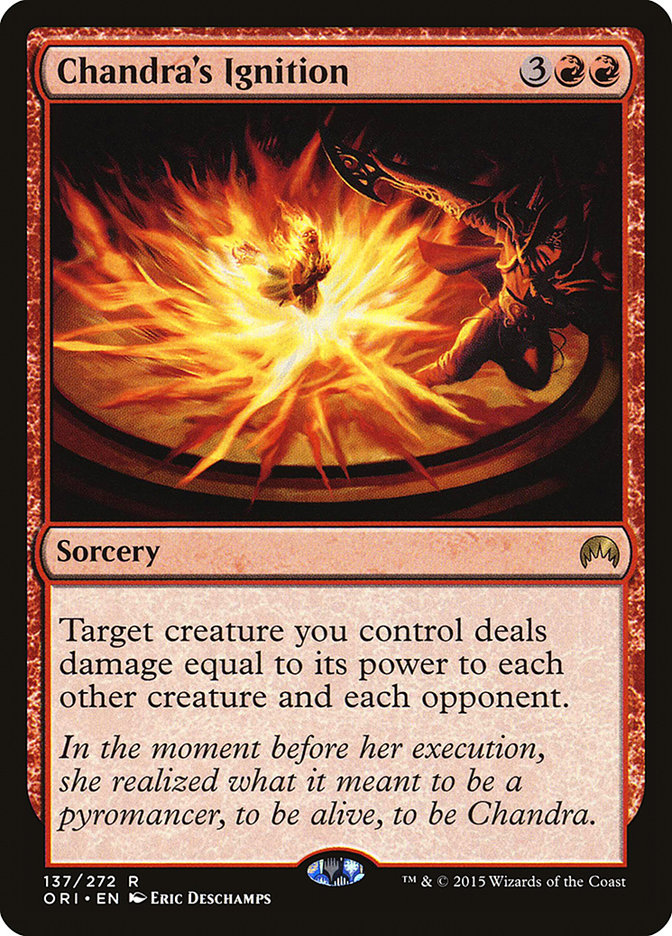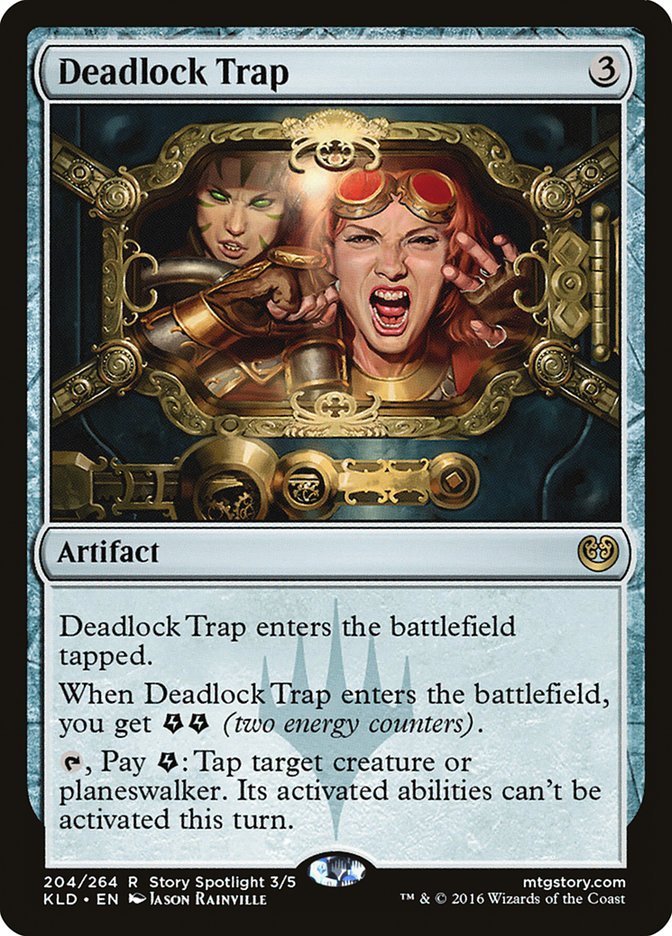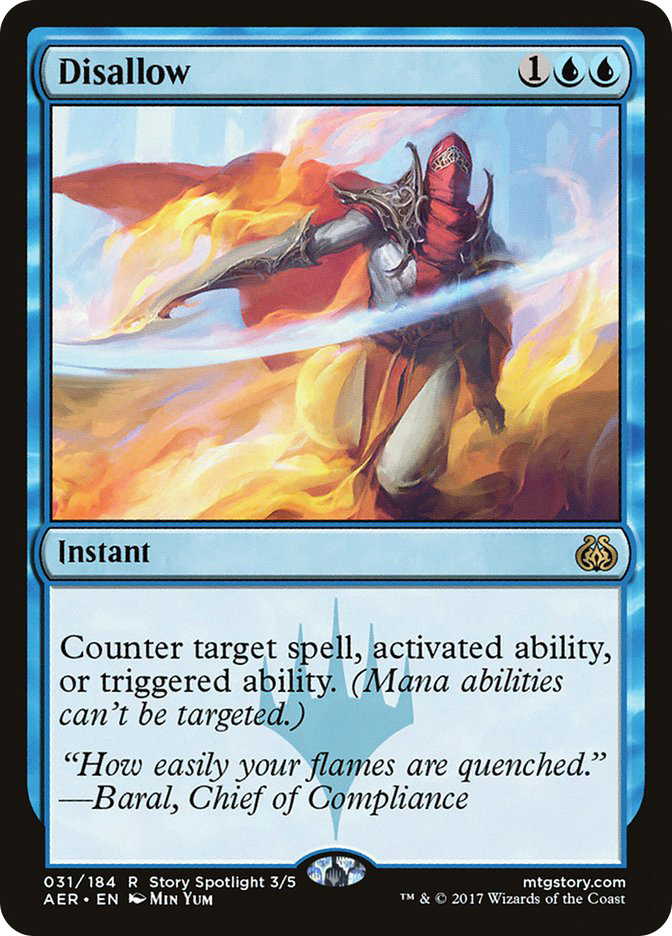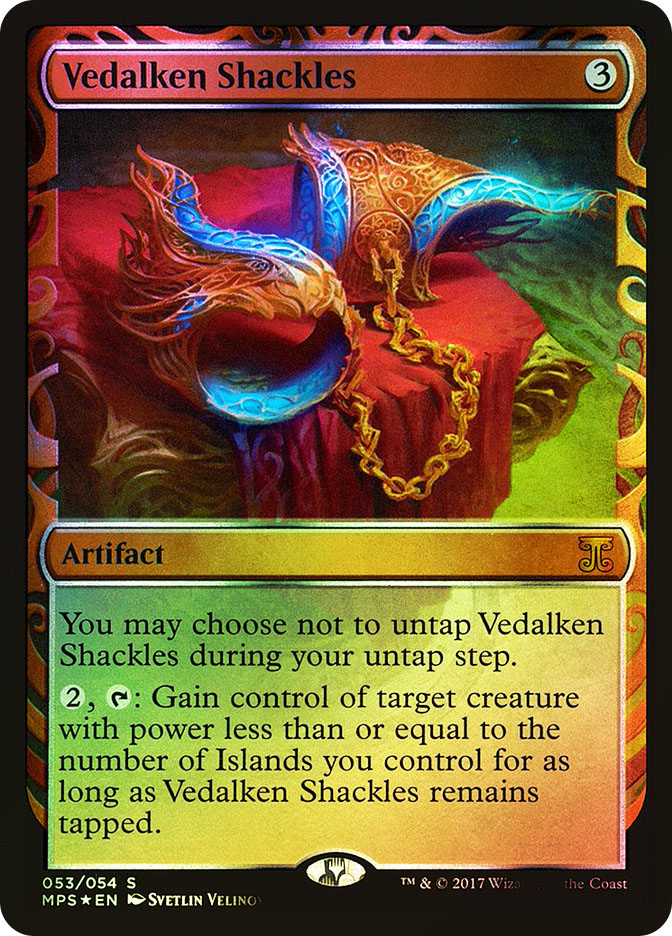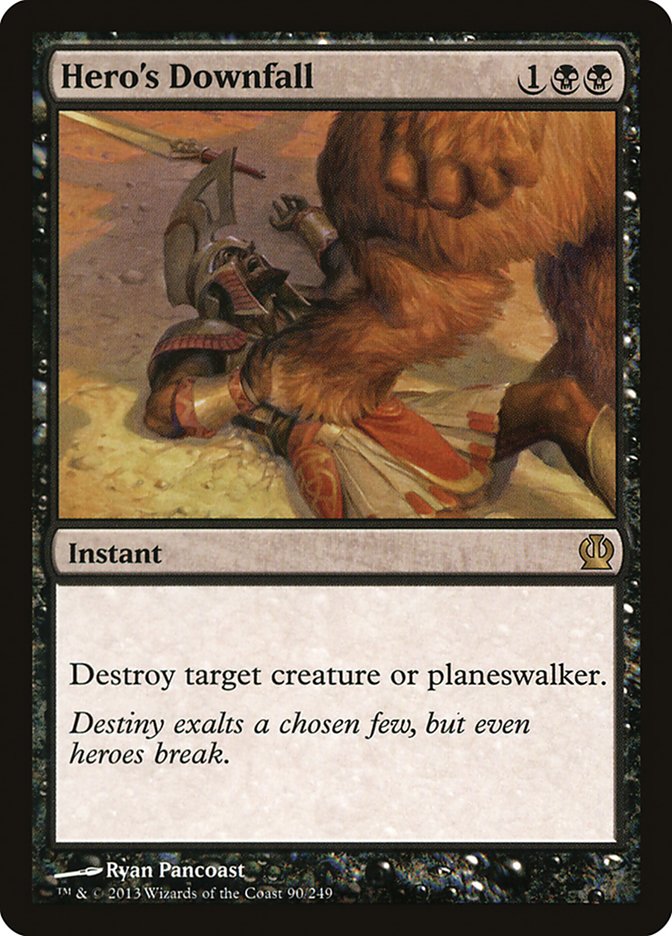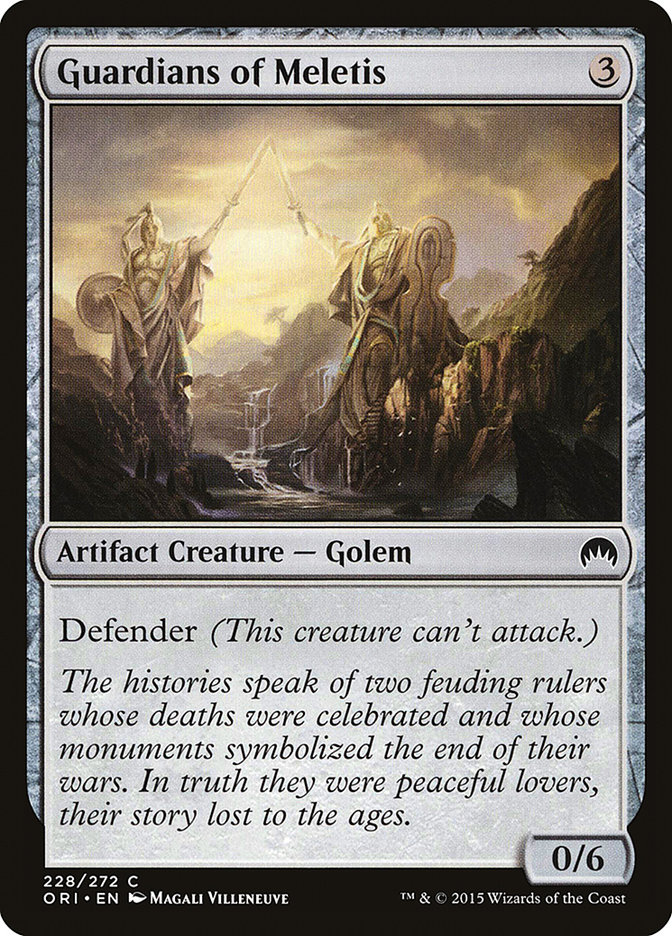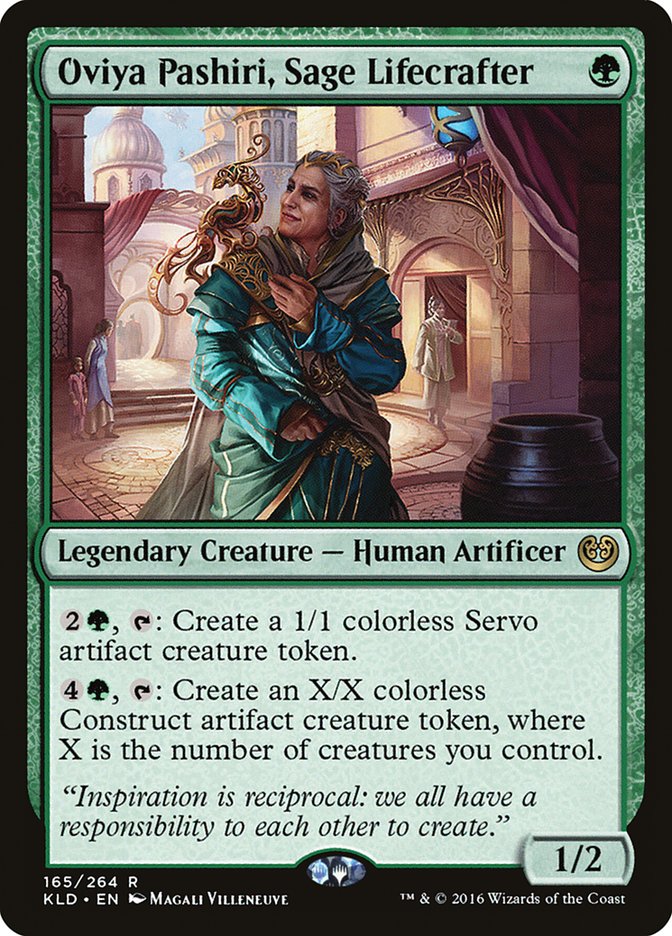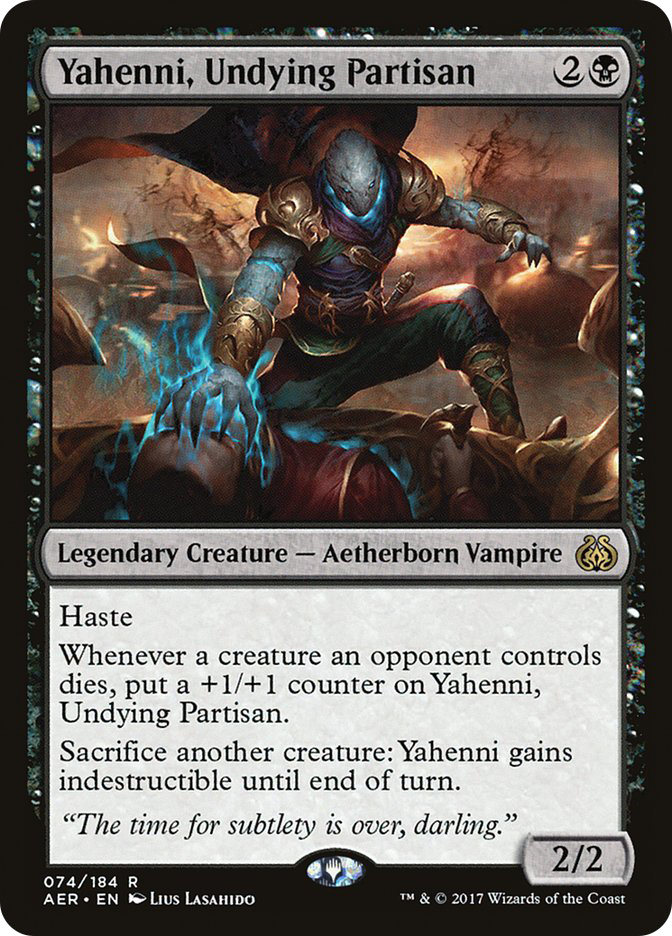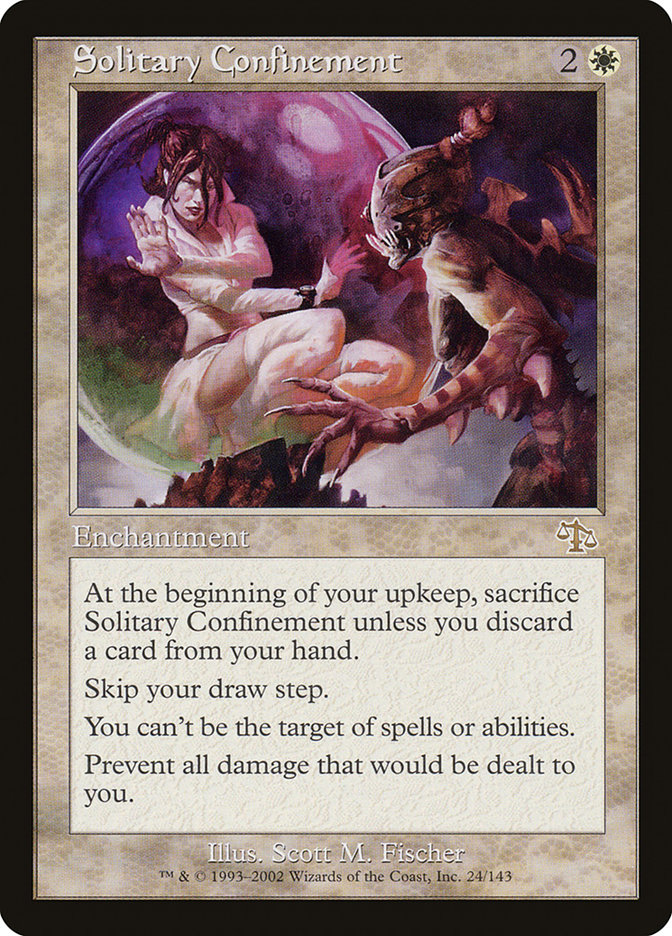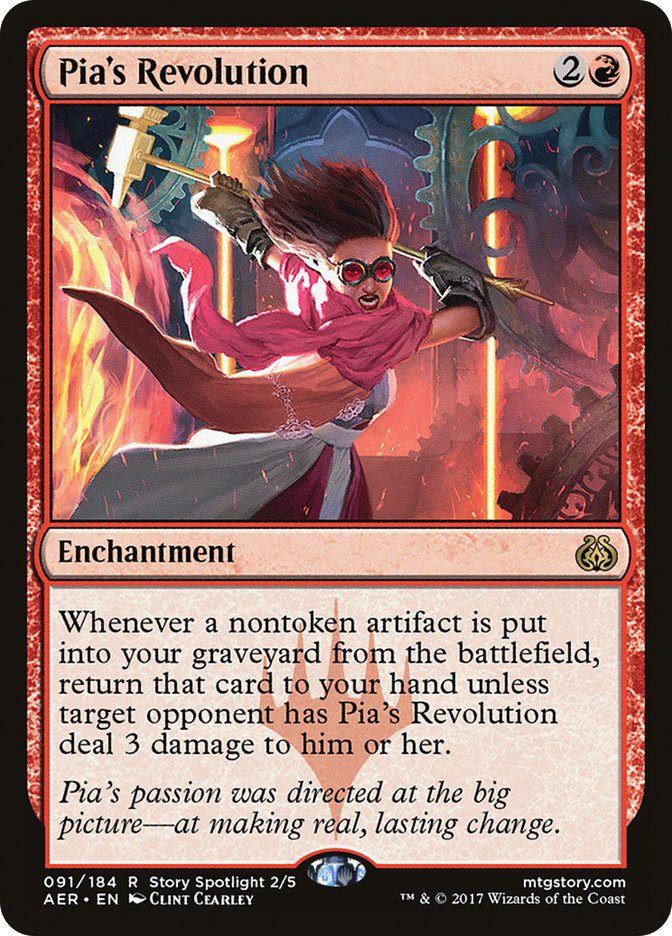As I type this, the Amonkhet setting is established, the story chugging along, the flavor review written. But even though the Gatewatch has moved on from the world of Kaladesh, my mind lingers there, in the high-security core of what once was the plane’s most notorious black-ops prison, in a single cell holding a single man: Dhiren Baral, formerly Baral, Chief of Compliance.
On a plane with a remarkably rich cast of supporting characters (another phenomenon I’ve noted in the past), Baral is among the most compelling. He also shows, in microcosm, the ways fantasy storytelling and Magic’s in particular have evolved over the past 25 years. It’s time to give Baral a closer look before his world is too far gone.
The Self-Hating Mage, Part 1
On the plane of Kaladesh, mages are extreme rarities. Consider this line from the story “Renegade Prime,” set shortly after the botched execution that ignited Chandra Nalaar’s spark, when Chandra’s mother Pia Nalaar recognizes Baral’s true nature:
“You’re…a mage?” Pia gasped. Her own daughter’s pyromancy aside, she’d never known another mage. Magic and magic users were not just scarce, they were regulated and watched more closely than aether itself.
Readers who remembered the story “Chandra’s Origin: Fire Logic” could have recalled that Baral was a mage of the suppressing or “antimagic” type, locking down the young Chandra’s pyromancy until her moment of true ignition. But as it turns out, Baral isn’t just a counterspell-happy mage; he’s also a self-hating mage. After Pia Nalaar knocks Baral’s mask off and sees Baral’s true, scarred face…
…there follows this classic villainous monologue:
“The materials that shape what we become are fixed the moment we are brought into this world. The fortunate of us will be born heroes. But there are a number of us who will be born malformed—dangerous aberrations to the course of nature. Perhaps they might even look and act like the rest that can threaten us [sic] from the shadows.”
Mask secured, he carefully draped his hood over his head. “Myself, I accept my nature—I’ll not hide or let others hide from the sentences they’ve been given. This is my destiny, to root out these hidden dangers, expose them, and bring them to justice.”
Pia Nalaar, seriously unimpressed, sends back a zinger: “Destined to wrestle with your own demons by hunting down children?”
While Pia Nalaar’s reply is rather on-the-nose in storytelling terms, it does lay out the core of Baral’s being. I’ll have more to say about Baral’s self-hatred in the context of past storytelling traditions later in this article.
The Story Re-Centered
Baral has been a viewpoint character in Magic only once, for part of “Burn,” and he has never gotten a real chance to tell his side of things. Yet the events of his life, at least as they relate to the Nalaars, are well-established, and they can be used to re-center a story around him instead of Chandra or Pia, much as John Gardner’s Grendel takes the epic poem Beowulf and re-centers it around the monster rather than the hero (or, more recently, as I took “Chandra’s Origin: Fire Logic” and re-centered it around one of Baral’s subordinates to create “A Footsoldier’s Confession“).
In this re-centered story, Dhiren Baral is first met as a captain of the Consulate forces. He is, as described early on, “a monolith of a man, stout and statuesque, with a face that seemed to taunt those around it for being of lesser handsomeness.”
He is also a mage, on a plane where this is rare and tightly regulated; despite his magnificent outward appearance, on the inside he considers himself abnormal, “freakish,” a “monster.” This is his tragic flaw, the seed of his demise.
Act I (Magic Origins): When Baral apprehends a suspected aether smuggler, a girl named Chandra Nalaar, she fights back with fire magic, catching him…and, apparently, her…by surprise. She runs for it, destroying a great deal of Consulate property in the process, and with her parents flees from the city.
When Baral’s superiors suggest he stop monitoring the Nalaar family, he defies them and instead orders a hunting party. He and the party capture Chandra and Pia Nalaar in the village of Bunarat, which is put to the torch on Baral’s orders; as for the father, Kiran Nalaar, Baral kills him on the spot.
The date for Chandra’s execution is set. Baral arranges to be the executioner. At the appointed time, Baral taunts Chandra, damping her pyromancy with his suppressive magic. But Chandra proves to be the stronger mage, overcoming all magical hindrances to unleash a fiery blast that knocks Baral away.
Afterward, Chandra Nalaar is nowhere to be found; unbeknownst to Baral, she has traveled to another world, her first trip as a planeswalker. For his part in the botched execution, Baral is demoted from captain to lieutenant. Lowered in status and scarred by Chandra’s flames, he gets his revenge by tormenting Pia Nalaar, visiting her frequently in prison to continue his psychological war on her.
On one of these visits, he opens the grate in her cell door, and Pia takes advantage, throwing an aether lamp at him and knocking off his mask. The fallen mask reveals his scarred face; his magical reaction betrays his interior nature to Pia, who starts to plan her revenge.
Act II (Kaladesh): Years later, Baral has worked his way back up the officers’ ranks and is now Chief of Compliance. Dovin Baan, Minister of Inspections, warns Baral that Chandra Nalaar somehow is alive and has appeared on Kaladesh. Perturbed by the reappearance of the pyromancer who scarred his flesh, Baral arranges an antimagic-reinforced Deadlock Trap that catches two others with Chandra…others he feels no qualms about killing off if it means Chandra dies.
After the surprise intervention of Ajani Goldmane, a mage of unknown species from another world, frees Chandra from the Deadlock Trap, Baral turns his attention back to Pia Nalaar, sending her into the arena for the Fateful Showdown he believes will end in her death. Even that doesn’t go as planned, though Tezzeret the Schemer’s Confiscation Coup, for which the Fateful Showdown was a distraction, succeeds.
Act III (Aether Revolt): After the Confiscation Coup, the city of Ghirapur is in revolt. After the renegades seize the Aether Hub, Tezzeret orders Baral to distract Chandra Nalaar and lure her away from the Aether Hub, which in turn would draw resources away from the Aether Hub’s defense.
Baral taunts Chandra Nalaar, luring her away from the Aether Hub. As they fight, Baral saps Chandra’s pyromancy with his antimagic and launches repeated verbal attacks, raising the specter of her father’s death and her mother’s suffering repeatedly.
When Oviya Pashiri, Sage Lifecrafter intervenes in their battle with a timely thrown Thopter, Baral orders an assault that critically wounds the elder woman. At last, the moment Baral has craved arrives: Chandra snaps and prepares to self-immolate. Only the influence of the interloper Nissa Revane (yet another mage from yet another world!), who talks Chandra down, keeps Baral from completing his revenge.
The few attacks Chandra got in, as well as a last wallop from one of Nissa’s Elementals, take their toll on Baral’s already compromised body, but worse is yet to come. Dovin Baan, who had earlier confronted Baral about the mismatch between his account of the burning of Bunarat Village and the self-evident truth of Chandra’s continued existence, has documented Baral’s every self-incriminating verbal assault. Dovin Baan arrests Baral, charging him with the murder of Kiran Nalaar and other crimes.
Baral, once commander of the infamous Dhund prison, is locked away there, fitted with special shackles that rob him of his magic. His first visitors are Pia Nalaar, now Consul of Allocation, and her daughter Chandra. Baral finds the situation fitting: he believes he will be taken for a public execution, the same fate he had visited upon numerous other mages. But Pia Nalaar tells him of a different fate: he will instead remain imprisoned and isolated for the rest of his natural life.
In a last effort to claim the death he believes is his due, he tries provoking Chandra once more, but Chandra withstands his monstrous words. The mother and daughter walk away, leaving Baral to strike uselessly at the window of his cell and rage against his fate.
The Self-Hating Mage, Part 2
In the context of Chandra Nalaar’s story, the one Wizards of the Coast chose, Baral is of course a villain, and a nasty one at that. In the context of Baral’s story, however, he is a tragic protagonist brought down by the crippling flaw of internalized self-hatred. Had he never met Chandra Nalaar, he likely would have lived out his life as a wretched persecutor of his own kind, but his encounter with her led to setbacks and finally ruin.
And what to make of that self-hatred, so virulent and so cruelly projected onto others?
Let’s go back to that monologue from “Renegade Prime,” a little shorter this time.
“But there are a number of us who will be born malformed—dangerous aberrations to the course of nature. Perhaps they might even look and act like the rest… Myself, I accept my nature—I’ll not hide or let others hide from the sentences they’ve been given. This is my destiny, to root out these hidden dangers, expose them, and bring them to justice.”
And some more choice quotes from Baral’s words and thoughts. From “Burn,” the deepest examination of Baral, while he’s taunting Chandra:
A high, giddy laugh of glee welled up from the pit of his stomach as he raced away from her, but he didn’t allow it past his teeth. He’d spent thirty years suppressing the things that bubbled up from within him.
Later, when he’s defeated and facing arrest:
“All mages are monsters,” he whispered to the sky.
From “Renewal,” the end (so far) of Baral’s story:
“Were you born to be hidden away? Freakish?”
As a minority within his society (in this case, mage versus non-mage), placed under restrictions others need not suffer because of a condition he did not ask for and cannot change, Baral is part of a long tradition of similar metaphors and oblique substitutes in speculative fiction. Rod Serling famously used The Twilight Zone to comment on and sometimes condemn the ways of the world through a speculative lens; Star Trek episodes such as “Let That Be Your Last Battlefield,” a dramatization of the absurdity of racism, served a similar function; and then there’s the X-Men franchise in comics and films, which has its own long section on Wikipedia.
More specifically, Baral is not visually distinguished from his peers (particularly before Chandra’s Ignition wounds and scars him). Twenty, ten years ago — in the context of Magic specifically, I would argue right up until Theros, when Magic began adding same-sex couples to its canon — Baral’s self-hatred likely would have been seen as a metaphor for internalized homophobia. Of course, because Baral exists on Kaladesh, where Oviya Pashiri, Sage Lifecrafter was widowed after her wife’s death, that metaphor is no longer particularly credible. Similarly, Magic Creative’s positive depiction of characters who reject a rigid, unchanging gender binary, such as Alesha, Who Smiles at Death and Yahenni, Undying Partisan, cuts off those metaphors.
This raises more interesting questions. Did Magic Creative mean for Baral to be a metaphor for another “invisible” minority status instead, such as political or religious belief (a strange choice, given the Kaladesh setting’s prominent political themes and irreligiosity so pointed that there are no Clerics at all in the block)? Is he instead a broader symbol of the corrosive power of self-hatred? Or is he simply a trope from another time, left without a foundation?
Baral’s Fate
Baral’s ultimate fate, effectively life imprisonment in solitary confinement without the possibility of release (Pia Nalaar command to “Stay and be forgotten,” which came not from Renegade Prime Pia but Consul of Allocation Pia), also reflects a deliberate choice made by Wizards Creative.
While it is not an obligation for a tragic protagonist to die (in Oedipus Rex, Oedipus blinds himself but lives through the end of the play), villains seldom survive the action (see: Edmund from King Lear). In fact, Baral is more than resigned to death; he feels entitled to it. From “Renewal:”
“So the inspectors sent you to lead me to my execution in the arena.” Baral rasped. “Fitting. Just like I had for all the other mages.”
***
“These spineless bureaucrats have no idea of the…filth that lurks amongst them. Easy enough when I kept them safe all these years! They owe me death in the arena—I want my due.”
***
“No! I know how this has to end,” he hissed.
The story “Renewal” sets up symmetry, only to break it. Just as Baral visited Pia in prison with malice on his mind, Pia repays the favor. But Chandra will not kill Baral, even though he tried to kill her. Neither will the government he corrupted through his actions, represented by Pia. Instead, he gets a life sentence of solitary confinement (that damning “be forgotten” from Pia Nalaar), with the added constant burden of the shackles that will not let him cast the magic he so despises. It’s cruel mercy.
As revolts go, the ending to the Aether Revolt is strangely bloodless. There’s a power-sharing agreement rather than a full toppling of the existing government structure; only Grand Consul Tezzeret and the corrupt Kambal, Consul of Allocation are out, with Pia Nalaar substituted for the latter.
While real-world rebellions, revolts, and revolutions can have wildly different outcomes even if closely linked by time and geography — to give two examples from among the Revolutions of 1989, the Velvet Revolution or Gentle Revolution in then-Czechoslovakia went down far more peaceably than the Romanian Revolution —the sudden shift from violent public executions to a seeming abolition of the death penalty seems abrupt.
Leaving Baral alive was a deliberate choice on the part of Wizards of the Coast, and not the easy “poetic justice” one Baral spoke of before it was denied. But why? Was Baral kept alive simply for possible future story use, a villain ready to be jailbroken for the inevitable Return to Kaladesh? Or was there a deeper reason behind it?
From his first appearance, Baral was set up as a walking contradiction. From “Chandra’s Origin: Fire Logic” comes this intriguing paragraph:
“We have nothing to fear from her, for we are members of an enlightened society of builders and creators.” Baral reached for the filigree cage on his desk that contained a small taper, and opened a little door in the cage. The shadow of his hand loomed across the walls. Baral didn’t touch the flame, but only held his hand near it. The flame dimmed and went out, leaving a sinuous line of smoke. “We know that fire never creates—it only destroys. Ultimately it will bring nothing but ruin to its wielder.”
It’s not the first time Baral has used the language of progress. Just a few paragraphs earlier:
“This is not about a couple of fugitives, soldier,” said the captain, not raising his voice above an even whisper. “It’s about the future. We need to show the people of this city that we’re prepared to move beyond the barbaric age of the past, to embrace progress. The girl is a remnant of a chaotic time. An obstacle. If we’re going to move forward, we’ll need our path to be clear. The consuls will understand that.”
“It’s about the future.”
“Move beyond the barbaric age of the past.”
“Embrace progress.”
“Remnant of a chaotic time.”
“An enlightened society.”
It’s pretty clear what Baral thinks of magic. Yet even in that earliest appearance he is what he hates, as shown by his magical no-touch snuffing of the candle. Further, in the real world, the vast majority of nations, regardless of whether or not they have capital punishment, do not conduct public executions. Capital punishment before a crowd ended in the United States in the 1930s; today it seems a distant, barbarous relic.
For an “enlightened society” in the Western progressive tradition — and it is hard to imagine a Magic Creative team who positively depicted Oviya Pashiri, Alesha, and Yahenni in any other — capital punishment itself would seem an abomination (as with the virtual absence of capital punishment in Europe). Baral’s corrupt system of secret imprisonment and public execution, not his magic, thus become the real obstacle to progress.
But the Kaladesh setting skips even the “private execution” phase, even for someone as monstrous as Baral (Pia again: “Your sentence begins and ends here.”). Who argued for his life in-story? Pia? Chandra? Ajani Goldmane? Or did the choice to leave Baral shackled in solitary confinement come from a real-world advocate…a choice, mind, that could very well amount to torture?
Closing the Grate
Ordinarily I wouldn’t spend close to 3000 words writing about a minor Magic character, even a well-written, complicated one. But Baral is more than complicated; he and the plot around him rest on unvoiced tropes and assumptions that are worth examining for clues to how the game’s writers might treat other characters in the future.
Speaking of other characters, who should receive my next “deep dive” into their lore?


